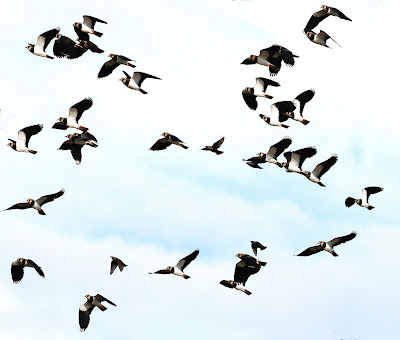Goldfinches give us a decent number of recoveries, a fact confirmed recently by ACV6977 one of last year’s young that set off last autumn in search of eternal summer and finished up in Belgium.
ACV697 was caught and ringed at our Oakenclough site on 12 October 2023, a time of year when common or garden Goldfinches occasionally go on to prove to us they can fly further than a neighbour’s garden.
The morning was a busy one of 61 captures, 30 of which were Goldfinches plus 15 Chaffinches and clearly a typical October morning of finch migration.
The Goldfinch was recaptured by other ringers on 12 February 2024 in Roeselare, a Belgian city and municipality in the Flemish province of West Flanders. By mid February the Goldfinch could be sexed as a male and then released.
And by now in mid October of 2024 it may be back in the fields of Flanders Belgium rather than spend the coming winter in wet and windy Lancashire.
Goldfinch ACV6977
Goldfinch
Goldfinch
Update - ACV6977 was captured again by the same Belgian ringers on 20 March 2024. We don't know for sure but it may be that the location was a feeding station to which the Goldfinch returned on a regular basis.
______________________________________________________________
And now I feel a rant coming on about yet more lunacy of the world in 2024. The gulls get it again, the much maligned creatures make an easy target for the thickos who increasingly seem to run Great Britain. And no, it is not The First of April, just yet another tale of how our elected representatives waste taxpayer’s money.
Common Gull
Lesser Black-backed Gull
A desperate council aims to cut numbers of marauding seagulls – by putting the birds on The Pill. Officials in Worcester are considering doping food with birth-control drugs as part of a “safe sex” drive for randy gulls. Council chiefs have tried for years to reduce the gull population in the city, including hiring hawks to scare them away and taking eggs from nests.
If the birth-control plan is approved, the council hopes it will lead to fewer attacks on people, particularly in the Blackpole area of the city.
Councillor Jill Desayrah, a Labour city councillor described the contraceptive option as “safe sex for seagulls”.
She said: “I am concerned that the increasing numbers of seagulls are getting out of hand. Many people contact me about the issues caused by having such a high concentration of seagulls around Blackpole.”
Councillor Desayrah said she wanted to “humanely reduce the number of gulls” by exploring methods used in other countries. "The Pill is already used to control pigeons in Barcelona and Venice."
She added: “I passed the idea onto Worcestershire Regulatory Services and they are following up on it, seeking permission from the relevant authority. I hope that one or a combination of these solutions will reduce the problem because I do feel it’s necessary to do something as soon as possible.”
The city’s annual Gull Population Survey revealed that 376 pairs live in the Blackpole retail parks and industrial estates. This accounts for more than 50 percent of the city’s entire gull population and an increase of three percent in the past year.
The majority are Lesser Black-Backed Gulls, which, along with all the other types, is a protected species.
They are attracted to the area by the many flat-roofed buildings and the waste from food outlets. (My bold PS)
Worcestershire Regulatory Services (WRS) receives complaints from residents about noise, faeces and aggressive behaviour during the nesting season.
Earlier this year an order banning people from feeding seagulls in the city centre was scrapped.
Councillor Alan Amos blasted the decision to axe the feeding ban, saying it would lead to an explosion in the numbers of the “vicious flying rats”.
He said: “As a councillor and former mayor of Worcester – where the vicious and brassy flying rats have waged war on residents in recent years, I have witnessed first-hand the problems the UK-wide epidemic is causing. One shop owner told me he’d seen a gull ferociously attack a young child in a pushchair, while a constituent emailed to say her dog had been attacked.”
A Worcester City Council spokesperson said: “An Annual Gull Report will be presented to the City Council’s Environment Committee on November 5. This will provide councillors with an opportunity to consider a gull management program for 2025.”
Reading this pile of poo while picturing the posturing and cognitive dissonance displayed by elected representatives at all levels I immediately relapsed into full birder/taxpayer mode.
For instance, gulls must be called gulls, not seagulls, there is no such thing as a "seagull". And preferably any discussions, proposals and policies should be based upon sound scientific research by understanding and using the correct species name together with the scientific equivalent. Joe Public is entitled to know that elected representatives are fully up to speed with subjects under discussion while being reassured that due diligence has been carried out before ever larger amounts of public money is spent on nonsense vanity projects.
Fish and Chips - Enjoy
Those squawking gulls dive bombing for chips at the beach may seem like nothing more than feathered delinquents but research has revealed that gulls are remarkably intelligent. There's much more to these birds than meets the eye. It turns out that those "criminal acts" and the ability to find new sources of food are in fact signs of incredible intelligence and adaptability, just as Charles Darwin indicated.
Well I don't know about you Dear Reader but I would suggest that it is the said councillors who need contraceptives so as to reduce their capacity to breed more of the same.




















































